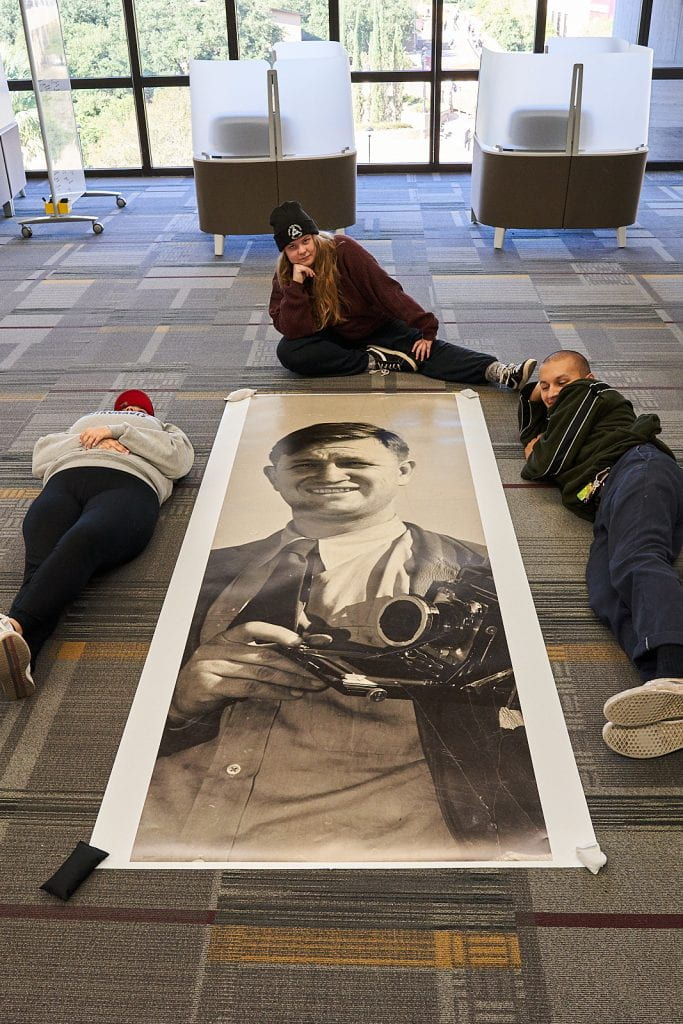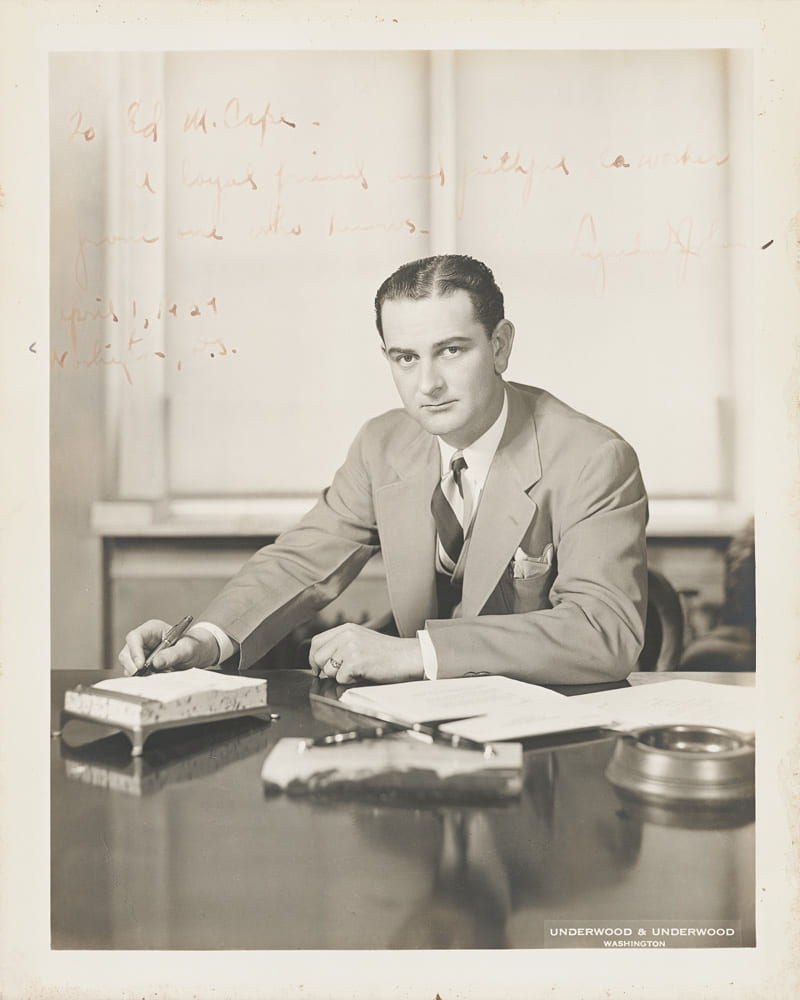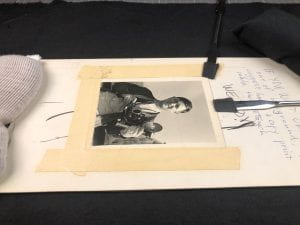In September 2021, the LBJ Museum in San Marcos, Texas requested assistance in preserving two prints at risk of further degrading while on display. To keep any further aging from affecting the original, I also provided replacement prints for viewing so the originals could be safely stored away. One of the images, a 1939 portrait of Lyndon Baines Johnson, also had a difficult to read inscription in faded red ink. The museum manager approved creating a black and white version on the image, since the original print’s color was largely due to staining and yellowing from age. Due to the strong color of the ink, I was then able to use a Black & White Filter in Photoshop to provide the museum with a much more legible print for display.
Author Archives: Erin Mazzei
A Larger Than Life View of Russell Lee
The variety of projects is always one of the more exciting parts of working here. For a Russell Lee exhibit that is currently on display at the Redwood Library & Athenæum in Newport, RI, we received a request through the Wittliff Collections to digitize two images of the photographer Russell Lee at a scale large enough to cover two walls in the show.
The dimensions of the photographs to digitize are 4.25″ x 3.25″ and 13.375″ x 7.875″ respectively, so creating a digital file from these with a high enough resolution to print at a final size of over 8′ at 100 px/in isn’t something even our best equipment can manage in a single shot. To solve this problem, we captured each photograph in smaller sections and then combined those together to create a seamless final image. The smaller photograph is a combination of 6 images in Photoshop for the final digital file, and the larger took only 2 images.
Once we had our final image, we knew we wanted to see for ourselves what they could look like when printed for the wall. This is where we love having the help of our digital technicians to demonstrate!

A cropped section of the smaller original photograph on the floor, with students for scale. From the left: Jessica Henriquez, Reba Jenson, and Allen Garza.
Tech Reflect: Lucy Lippard Notebooks
Tech Reflect is a platform for Digital & Web Services technicians to look-back on a particular project and share their experiences, thoughts, and lessons learned.
By Austen Villacis, Digital Imaging Technician
Occasionally, requests will come in from Texas State faculty for special projects. One such request came from Dr. Erina Duganne, an Associate Professor of Art History in the College of Art and Design, and included a collection of 5 personal notebooks from art critic Lucy Lippard. The notebooks date from 1983 to 1984, and range in size, the largest being 4″x6″ inches.
After meeting with Dr. Duganne to examine the materials in-person and discuss the goals for the project, the first step was to build a capture station with the following things in mind:
Quality: Dr. Duganne might use some of these images for an exhibit at Tufts University in 2020 and an accompanying exhibition catalog.
Efficiency: The total number of pages in the notebooks in over 1000, so it’s essential that the capture station is efficient.
Careful Handling: These nearly 40-year-old materials are on loan, not for the library to keep.
Versatility: The notebooks themselves vary in size, so I need the capture station to be versatile.
Tech Reflect: It’s Only Rock N’ Roll Newspapers
Tech Reflect is a platform for Digital & Web Services technicians to look-back on a particular project and share their experiences, thoughts, and lessons learned.
Last November, nearly a full run of 41 issues of It’s Only Rock N’ Roll (IORNR), an alternative San Antonio-focused, alternative punk and New Wave rock music magazine published from 1979 to 1982, were donated to The Wittliff Collections here at Texas State University, adding to the new Texas Music collecting scope of The Wittliff. The newspaper was a labor of love for its managing editor and publisher, music journalist Ron Young, who wrote for the San Antonio Light and San Antonio Express-News. For more information on Young and the newspaper, please see this 2017 article on the San Antonio Express News’s MySanAntonio.com and this 2016 article in the San Antonio Express News includes more information on the newspaper.
My primary tasks were:
- Handling with extreme care
- Photographing each page
- Post-processing and output
- Move files into the Wittliff Collections’ shared drive for ingest into institutional repository
Picking Up a Fallen Photograph with Photoshop
When photographing exhibitions in the Wittliff Collections‘ Writer’s Room, our focus has been documenting the exhibit cases, as seen in this past blog post, but the recent Legends of Tejano Music exhibition had materials on display everywhere! While finalizing my documentation photographs, I decided to create a panorama from multiple images to better showcase the details along the back walls. Unfortunately, one of the photos had fallen from the wall between setup and capture of the best frame for part of my panorama. Surprisingly, the photograph landed in a lucky position and I was able to restore it to its proper location using Adobe Photoshop.
The Writer’s Room Dance
The Writer’s Room on the 7th floor of Alkek Library hosts semi-annual exhibits from the Wittliff Collections that are documented by Digital and Web Services. With five glassed-in wall cases and multiple light sources, the room is challenging to photograph! We photograph each case multiple times with a tripod-mounted camera while a sheet of black foam core is moved throughout the frame to flag, or block, the many reflections in the glass. These shots are digitally combined into a single image without distracting reflections.



